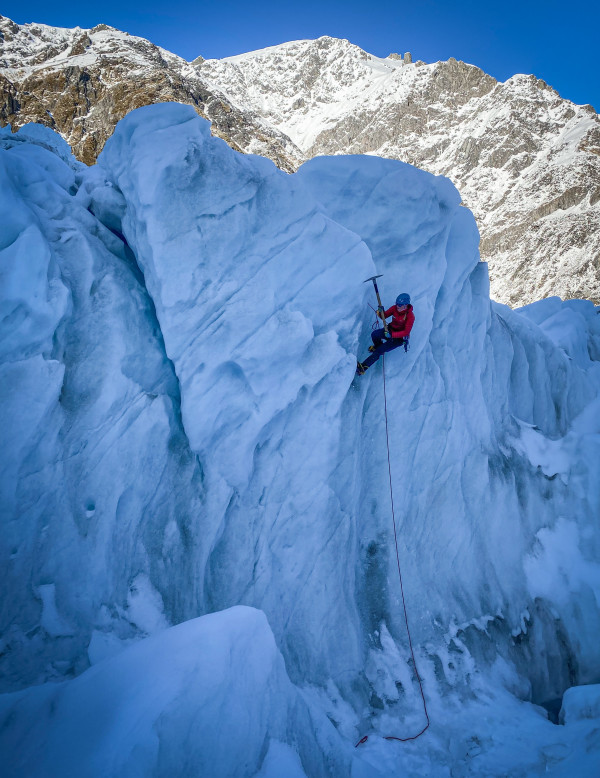Tall seracs dominate the horizon like a colossal Jenga set, with towers of ice rising from the glacier, some precariously leaning as if an ice giant has mischievously removed a supporting block. Crevasses crisscross the glacier, creating a labyrinth of fissures as the ice surface fractures while the glacier maneuvers over the underlying terrain.
At Franz Josef Glacier Guides, the more experienced guides form a team known as the Ice Support team. Their primary responsibility isn't to guide the manuhiri (guests) but to carve out safe trails into the glacier's more challenging areas. This allows us to showcase the steep, dynamic parts of the glacier. The Ice Support team frequently encounters a myriad of logistical problems, as a result of the ever-changing nature of the ice. Overcoming these challenges is part of the adventure and excitement of the job!
The start of the day
The day for an Ice Support guide begins early, around 6 a.m. The first task is to check the weather. Like many outdoor professionals, we prefer to interpret local weather conditions ourselves rather than rely solely on pre-written forecasts. By combining information from several weather websites we can make an informed decision about the day’s operations. This task can feel daunting, as the entire day's activities hinge on an accurate weather prediction. We understand that our guests have often travelled great distances, and we strive to provide them with the best possible glacier experience.
Preparing for the day ahead
By 7 a.m., we arrive at work and review the handover notes from the previous day’s Ice Support team. This briefing helps us prepare and plan for the necessary tasks to ensure the trails are safe for guided trips. I then pack my bag, ensuring I have all the required equipment, such as ropes and ice screws.
Next, we gather with the wider guiding team to discuss the day's weather, potential hazards on the trails, and any other relevant business. This ensures everyone heading onto the glacier is well-informed and has the opportunity to voice any concerns or suggestions.
Heading out to the glacier
The team then splits up to tackle their designated roles. Ice Support guides and a few guiding staff are on the first helicopter flight of the day, departing at 7:30 am to prepare the trails and helipad. As the helicopter lands directly on the ice, we must carefully cut a flat landing pad in the ice, a task that requires daily maintenance due to the glacier’s constant movement and change.
If we are operating in a new area or after a hiatus due to inclement weather, the day typically unfolds as follows: the guides flatten the helipad while the Lead Ice Support scouts ahead into the icefall, marking a safe path by cutting steps into the ice. Once the helipad is complete, the guides follow, carving step lines into the steeper sections. All track building is done by hand using long, heavy axes similar to pickaxes, allowing us to create safe, familiar trails for guests who may be new to glacier walking.
Ensuring safety and stability
While the team carves the trail, the Ice Support’s focus is on placing the trail in the safest possible location, paying special attention to any overhead hazards. Sometimes, this requires scaling tall ice walls and rappelling down to dislodge loose ice blocks, ensuring they won’t fall during the day. Rappelling down an ice wall while knocking loose ice below with a pickaxe is an exhilarating experience, and everyone in the role finds it incredibly rewarding.
Welcoming our manuhiri (guests)
Once a safe path through and around the icefall is established, it’s time to welcome the manuhiri. After they are flown in and land on the freshly cut helipad, the guiding crew takes over, leading them along the safe, ready-for-use track. Meanwhile, the Ice Support team shifts focus to building future trails and scouting new areas for exploration. If the weather appears changeable, our attention turns to monitoring cloud formations to ensure timely communication with the guides and base, facilitating earlier flights off the glacier if necessary.
Wrapping up the day
With the hard work done, we return to base to document changes to the track and hazard developments for the next day’s team. We hang up any used gear to dry and check all personal protective equipment before calling it a day, usually wrapping up around 5:30 pm during summer.

Photo: Ice Support Guide Sarina in action removing a block of ice from above the trail - A perfect snapshot of the demanding yet exhilarating work the Ice Support team does.
Training and expertise
To qualify for the Ice Support role, guides must demonstrate a high level of understanding of glacial hazards and trail safety. Training involves certification by the New Zealand Mountain Guides Association (NZMGA) and an intensive, experience-building program shaped by decades of knowledge. This includes skills specific to the Franz Josef Glacier, such as advanced step cutting, rescue scenarios, ice climbing, ice hazard management, and team leadership. Guides also learn about the history of guiding on the glacier and the surrounding area.
Ice Support Guide Sarina in action removing a block of ice from above the trail—a perfect snapshot of the demanding yet exhilarating work we do as part of the Ice Support team.
